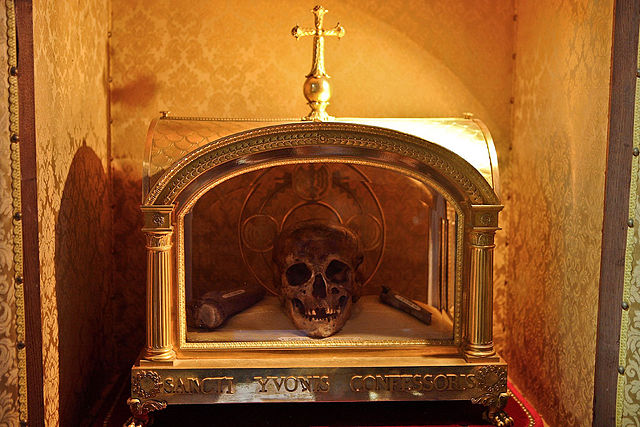In Christianity, the translation of relics is the removal of holy objects from one locality to another ; usually only the movement of the remains of the saint's body would be treated so formally, with secondary relics such as items of clothing treated with less ceremony. Translations could be accompanied by many acts, including all-night vigils and processions, often involving entire communities.
Depiction of St. Corbinian's relics being moved to Freising from Merano. From a panel in the crypt of Freising Cathedral.
Translation of the relics of St. Gregory to the monastery of Petershausen.
The Honorable Head of Venerable Macarius (in the golden reliquary held by Archbishop Georgy of Nizhny Novgorod and Arzamas) visits the city of Kstovo during its translation from Nizhny Novgorod's Pechersky Ascension Monastery to Makaryev Monastery
17th-century icon of the Translation of the Relics of St. Nicholas of Myra, from Myra in Asia Minor to Bari, Italy in 1087 (Historic Museum in Sanok, Poland).
In religion, a relic is an object or article of religious significance from the past. It usually consists of the physical remains or personal effects of a saint or other person preserved for the purpose of veneration as a tangible memorial. Relics are an important aspect of some forms of Buddhism, Christianity, Islam, shamanism, and many other religions. Relic derives from the Latin reliquiae, meaning "remains", and a form of the Latin verb relinquere, to "leave behind, or abandon". A reliquary is a shrine that houses one or more religious relics.
The reliquary and skull of Saint Ivo of Kermartin (St. Yves or St. Ives) (1253–1303), in Tréguier, Brittany, France
Shrine of Saint Lachtin's Arm, 12th century, Irish
An amphora depicting a Greek hero cult in honor of Oedipus (Apulian red-figure, 380–370 BC)
Buddha relics from Kanishka's stupa in Peshawar, Pakistan, now in Mandalay, Myanmar (2005)








